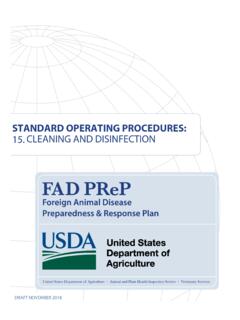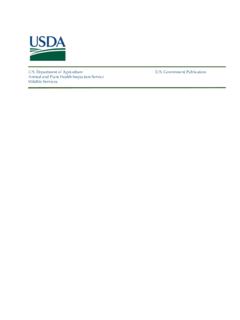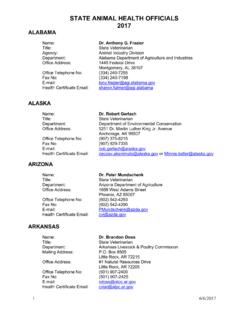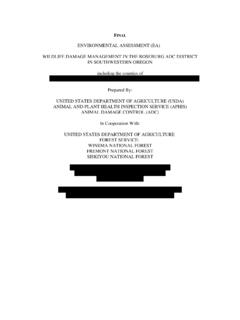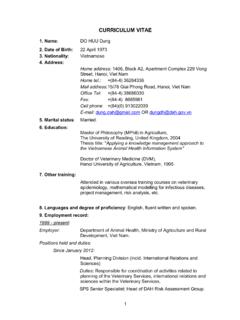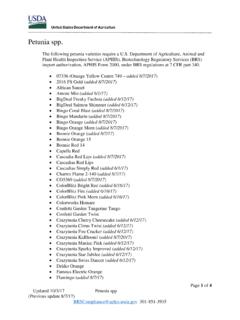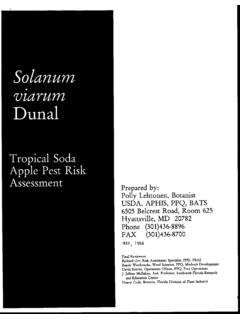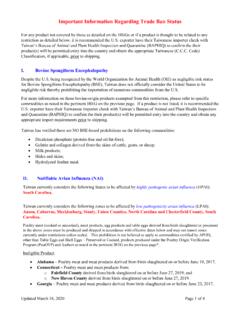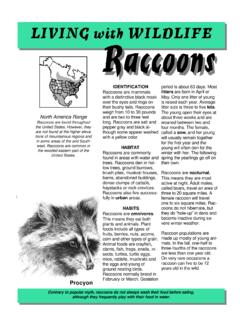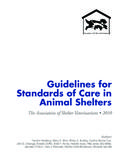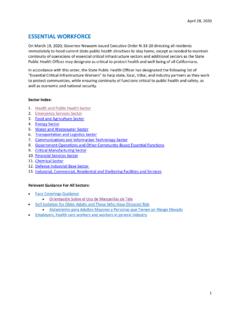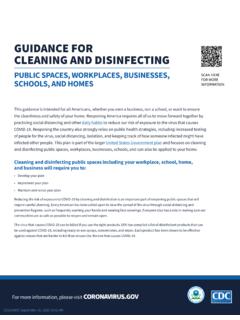Transcription of STANDARD OPERATING PROCEDURES: DISPOSAL
1 STANDARD OPERATING JANUARY 2014 File name: FAD_Prep_Disposal_SOP_Jan2014_07202016_F ixednumber SOP number: 14 Lead section: Preparedness and Incident Coordination Version number: Draft Effective date: January 2014 Review date: January 2017 SOP Manual ii DISPOSAL The Foreign animal Disease Preparedness and Response Plan (FAD PReP) STANDARD OPERATING Procedures (SOPs) provide operational guidance for responding to an animal health emergency in the United States. These draft SOPs are under ongoing review. This document was last updated in January 2014. Please send questions or comments to: National Preparedness and Incident Coordination Veterinary Services animal and Plant Health Inspection Service Department of Agriculture 4700 River Road, Unit 41 Riverdale, Maryland 20737 Telephone: (301) 851-3595 Fax: (301) 734-7817 E-mail: While best efforts have been used in developing and preparing the FAD PReP SOPs, the Government, Department of Agriculture (USDA), and the animal and Plant Health Inspection Service and other parties, such as employees and contractors contributing to this document, neither warrant nor assume any legal liability or responsibility for the accuracy, completeness, or usefulness of any information or procedure disclosed.
2 The primary purpose of these FAD PReP SOPs is to provide operational guidance to those government officials responding to a foreign animal disease outbreak. It is only posted for public access as a reference. The FAD PReP SOPs may refer to links to various other Federal and State agencies and private organizations. These links are maintained solely for the user's information and convenience. If you link to such site, please be aware that you are then subject to the policies of that site. In addition, please note that USDA does not control and cannot guarantee the relevance, timeliness, or accuracy of these outside materials. Further, the inclusion of links or pointers to particular items in hypertext is not intended to reflect their importance, nor is it intended to constitute approval or endorsement of any views expressed, or products or services offered, on these outside websites, or the organizations sponsoring the websites.
3 Trade names are used solely for the purpose of providing specific information. Mention of a trade name does not constitute a guarantee or warranty of the product by USDA or an endorsement over other products not mentioned. USDA prohibits discrimination in all its programs and activities on the basis of race, color, national origin, sex, religion, age, disability, political beliefs, sexual orientation, or marital or family status. (Not all prohibited bases apply to all programs.) Persons with disabilities who require alternative means for communication of program information (Braille, large print, audiotape, etc.) should contact USDA s TARGET Center at (202) 720-2600 (voice and telecommunications device for the deaf [TDD]). File name: FAD_Prep_Disposal_SOP_Jan2014_07202016_F ixednumber SOP number: 14 Lead section: Preparedness and Incident Coordination Version number: Draft Effective date: January 2014 Review date: January 2017 SOP Manual iii DISPOSAL To file a complaint of discrimination, write USDA, Director, Office of Civil Rights, Room 326-W, Whitten Building, 1400 Independence Avenue SW, Washington, DC 20250-9410 or call (202) 720-5964 (voice and TDD).
4 USDA is an equal opportunity provider and employer. SOP Manual iv DISPOSAL Contents Introduction .. 14-5 .. 14-6 Preparedness Goals .. 14-6 Response Goals .. 14-7 Guidelines .. 14-7 Coordination .. 14-7 Assumed Ongoing or Completed Response Activities .. 14-8 Purpose .. 14-8 Responsibilities .. 14-8 Federal 14-8 DHS .. 14-9 HHS .. 14-9 USDA .. 14-10 EPA .. 14-11 .. 14-11 DISPOSAL Group Supervisor .. 14-13 DISPOSAL Team Leader .. 14-14 Procedures .. 14-14 DISPOSAL Team Member .. 14-15 Site-Specific Assessment .. 14-15 Planning Site-specific DISPOSAL Plan .. 14-16 Outline .. 14-16 Background .. 14-16 Site Characteristics .. 14-16 Waste Classification .. 14-17 Selecting Site-Specific DISPOSAL Options.
5 14-19 Regulatory Permits and Approvals .. 14-28 Materials, Supplies, and Equipment .. 14-29 Personnel Training and Briefings .. 14-30 Operational Timeline for DISPOSAL .. 14-31 QA/QC .. 14-31 Operations .. 14-32 Site Preparation .. 14-32 Waste Characterization .. 14-32 Regulatory Permits and Approvals .. 14-33 Materials, Supplies, and Equipment .. 14-33 DISPOSAL Options Implementation .. 14-33 Operational Timeline for DISPOSAL .. 14-40 QA/QC .. 14-40 Demobilization .. 14-41 SOP Manual v DISPOSAL Attachment Composting .. 14-42 Attachment 14-48 Attachment Landfilling .. 14-50 Attachment Fixed 14-53 Attachment Air-Curtain Incineration .. 14-55 Attachment Open-Air Burning .. 14-57 Attachment Unlined Burial.
6 14-59 Attachment EPA Considerations for Waste Management Decisions .. 14-61 Attachment Land Area or Excavation Volume Required for Trench Burial .. 14-68 Attachment Transfer and Chain of Custody Form .. 14-72 Attachment Training .. 14-73 Attachment Acknowledgements .. 14-74 Attachment Acronyms .. 14-75 SOP Manual 14-6 DISPOSAL Introduction During a foreign animal disease (FAD) outbreak, effective DISPOSAL of animal carcasses and materials is a key component of a successful response. Proper DISPOSAL can help prevent or mitigate the spread of pathogens. The overall goal is to protect the agricultural and national economy through the control and containment of disease by conducting operations in a timely, safe, biosecure, aesthetically acceptable, and environmentally responsible manner.
7 If any materials (for example, bedding or feed) are potentially contaminated with an FAD virus, they must undergo treatment or DISPOSAL to inactivate or contain the virus. Wastes requiring DISPOSAL following an FAD outbreak include: carcasses; milk products; contaminated manure, litter, and bedding; contaminated feed; contaminated personal protective equipment (PPE); contaminated materials and equipment that cannot be cleaned and disinfected; and antimicrobials from cleaning and disinfecting. This SOP focuses on the responsibilities of DISPOSAL personnel, evaluation of DISPOSAL options, selection and execution of optimal methods, and the DISPOSAL of related waste for FAD agents that affect livestock and poultry. Key high priority FAD agents include, but are not limited to the following: highly pathogenic avian influenza (HPAI) foot-and-mouth disease (FMD) classical swine fever (CSF) Rift Valley Fever (RVF) virulent Newcastle disease virus (vNDV).
8 Several key animal and Plant Health Inspection Service (APHIS) documents complement this SOP and provide further detail when necessary. For more information, please see the following APHIS documents: Foreign animal Disease Preparedness and Response Plan (FAD PReP)/National animal Health Emergency Management System (NAHEMS) Guidelines: Biosecurity cleaning and Disinfection (C&D) DISPOSAL Health and Safety Mass Depopulation and Euthanasia Personal Protective Equipment (PPE). FAD PReP SOPs: Biosecurity C&D Mass Depopulation and Euthanasia SOP Manual 14-7 DISPOSAL Health and Safety/PPE Information Management. For individuals who have access to the APHIS intranet, these documents are available on the internal APHIS FAD PReP website: Publicly available documents are located on the APHIS website at This SOP also draws the latest information from other sources such as current best practices documented on university extensions websites and from working groups.
9 However, because research on best practices is constantly changing and a consensus has not yet been reached on details of specific procedures, the reader should seek the advice of DISPOSAL experts and exercise judgment before implementing any of the DISPOSAL options. The purpose of this document is to give the reader all the reasonable options and describe the procedures for different DISPOSAL methods. This document also serves to give the reader a portal view into the different DISPOSAL methods to allow them to choose the option that is most suitable based on Federal, State, and local restrictions pertinent to the specific area of concern. Some useful resources include: Cornell University Waste Management Institute Kansas State University, Purdue University, and Texas A&M University University of Nebraska at Lincoln Extension # Washington State University Agricultural Extension Goals Preparedness Goals The preparedness goals for DISPOSAL are as follows: Establish DISPOSAL protocols or procedures that meet regulatory requirements before an outbreak, for consistency and safeguarding.
10 Identify suitable DISPOSAL personnel, supplies, materials, and equipment prior to an outbreak. Prevent the spread of the disease agent with little or no effect on the environment, considering community preferences, and conserving meat or animal protein if logistically supportable from a biosecurity viewpoint. SOP Manual 14-8 DISPOSAL Response Goals The response goal for DISPOSAL is to properly dispose of contaminated and potentially contaminated materials, including animal carcasses, as soon as possible while maximizing pathogen containment, environmental sustainability, stakeholder acceptance, and cost effectiveness. Guidelines State and local regulations and procedures for FAD-exposed or infected animal carcasses, memoranda of understanding, prior contracting, or other mechanisms need to be reviewed and regularly updated to ensure DISPOSAL capability.
